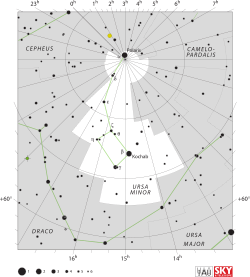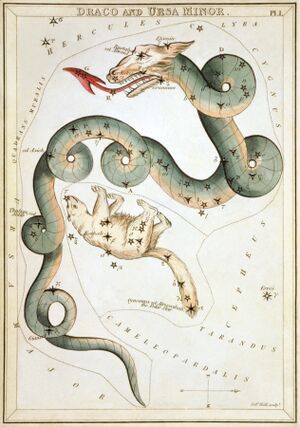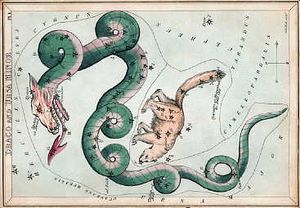الدب الأصغر (كوكبة)
| كوكبة | |
 | |
| الاختصار | UMi |
|---|---|
| Genitive | Ursae Minoris |
| الصعود المستقيم | 15 |
| الميل | +75 |
| المساحة | 256 sq. deg. (56th) |
| النجوم الرئيسية | 7 |
| باير/فلامستيد stars | 23 |
| نجوم بكواكب | 1 |
| Stars brighter than 3.00m | 2 |
| نجوم ضمن 10.00 pc (32.62 س.ض.) | 0 |
| ألمع نجم | Polaris (2.02m) |
| أجرام مسييه | 0 |
| زخات الشهب | Ursids |
| الكوكبات المتاخمة | Draco Camelopardalis Cepheus |
| Visible at latitudes between +90° and −10°. Best visible at 21:00 (9 p.m.) during the month of June. | |
كوكبة الدب الأصغر أقرب الكوكبات إلى القطب الشمالي وترسم في الخرائط وعلى الكرات السماوية بصورة دب صغير قائم الذيل وفى طرفه نجم كبير لامع واضح هو نجم القطب الشمالي وهو لايقع في القطب تماما ولكن يبعد عنه بمقدار درجة و20 دقيقة. وهى كوكبة أبدية الظهور يشاهدها الراصد على مدار السنة في الوضع نفسه من السماء. تغطي مساحة سماوية تبلغ نحو 256 درجة مربعة وقد رسمت على صورة دب صغير قائم الذنب وفى طرف ذنبه (نجم القطب) الشهير الذى أستخدم قديما دليلا الى الجهات الأربع
. . . . . . . . . . . . . . . . . . . . . . . . . . . . . . . . . . . . . . . . . . . . . . . . . . . . . . . . . . . . . . . . . . . . . . . . . . . . . . . . . . . . . . . . . . . . . . . . . . . . . . . . . . . . . . . . . . . . . . . . . . . . . . . . . . . . . . . . . . . . . . . . . . . . . . . . . . . . . . . . . . . . . . . .
التاريخ

In the Babylonian star catalogues, Ursa Minor was known as the "Wagon of Heaven" (MULMAR.GÍD.DA.AN.NA, also associated with the goddess Damkina). It is listed in the MUL.APIN catalogue, compiled around 1000 BC, among the "Stars of Enlil"—that is, the northern sky.[2]
According to Diogenes Laërtius, citing Callimachus, Thales of Miletus "measured the stars of the Wagon by which the Phoenicians sail". Diogenes identifies these as the constellation of Ursa Minor, which for its reported use by the Phoenicians for navigation at sea were also named Phoinikē.[3][4] The tradition of naming the northern constellations "bears" appears to be genuinely Greek, although Homer refers to just a single "bear".[5] The original "bear" is thus Ursa Major, and Ursa Minor was admitted as the second, or "Phoenician Bear" (Ursa Phoenicia, hence Φοινίκη, Phoenice) only later, according to Strabo (I.1.6, C3) due to a suggestion by Thales, who suggested it as a navigation aid to the Greeks, who had been navigating by Ursa Major. In classical antiquity, the celestial pole was somewhat closer to Beta Ursae Minoris than to Alpha Ursae Minoris, and the entire constellation was taken to indicate the northern direction. Since the medieval period, it has become convenient to use Alpha Ursae Minoris (or "Polaris") as the North Star. (Even though, in the medieval period, Polaris was still several degrees away from the celestial pole.[6][أ] ) Now, Polaris is within 1° of the north celestial pole and remains the current Pole star. Its Neo-Latin name of stella polaris was coined only in the early modern period.[7]
The ancient name of the constellation is Cynosura (Greek Κυνοσούρα "dog's tail"). The origin of this name is unclear (Ursa Minor being a "dog's tail" would imply that another constellation nearby is "the dog", but no such constellation is known).[8] Instead, the mythographic tradition of Catasterismi makes Cynosura the name of an Oread nymph described as a nurse of Zeus, honoured by the god with a place in the sky.[9] There are various proposed explanations for the name Cynosura. One suggestion connects it to the myth of Callisto, with her son Arcas replaced by her dog being placed in the sky by Zeus.[8] Others have suggested that an archaic interpretation of Ursa Major was that of a cow, forming a group with Boötes as herdsman, and Ursa Minor as a dog.[10] George William Cox explained it as a variant of Λυκόσουρα, understood as "wolf's tail" but by him etymologized as "trail, or train, of light" (i.e. λύκος "wolf" vs. λύκ- "light"). Allen points to the Old Irish name of the constellation, drag-blod "fire trail", for comparison. Brown (1899) suggested a non-Greek origin of the name (a loan from an Assyrian An‑nas-sur‑ra "high-rising").[11]
An alternative myth tells of two bears that saved Zeus from his murderous father Cronus by hiding him on Mount Ida. Later Zeus set them in the sky, but their tails grew long from their being swung up into the sky by the god.[12]
Because Ursa Minor consists of seven stars, the Latin word for "north" (i.e., where Polaris points) is septentrio, from septem (seven) and triones (oxen), from seven oxen driving a plough, which the seven stars also resemble. This name has also been attached to the main stars of Ursa Major.[13]
In Inuit astronomy, the three brightest stars—Polaris, Kochab and Pherkad—were known as Nuutuittut "never moving", though the term is more frequently used in the singular to refer to Polaris alone. The Pole Star is too high in the sky at far northern latitudes to be of use in navigation.[14] In Chinese astronomy, the main stars of Ursa Minor are divided between two asterisms: 勾陳 Gòuchén (Curved Array) (including α UMi, δ UMi, ε UMi, ζ UMi, η UMi, θ UMi, λ UMi) and 北極 Běijí (Northern Pole) (including β UMi and γ UMi).[15]
الدب الأصغر كوكبة صغيرة شهيرة عرفتها الحضارات القديمة وسماها بطليموس في المجسطي بالدب الأصغر وذكرها الصوفي بقوله:
فأقرب كوكبة إلى القطب الظاهر الشمالي كوكبة الدب الأصغر.
وقال أيضا: فإن العرب تسمي السبعة على الجملة نعش والثلاثة التى على الذنب "بنات".
وتتكون مجموعة الدب الاصغر من نجوم كثيرة ونختار منها ألمع سبع نجوم التى تحددها منها أربعة على شكل مربع وتسمى بالنعش والثلاثة التى على الذيل تسمى بنات نعش.
- ويسمى نجم القطب بالـجدى وهذا النجم يرشد على معرف خط العرض للمكان.
- ألفا الدب الأصغر وهو النجم القطبي أو الجدي من (القدر الثاني)
- بيتا الدب الأصغر ويسمى "الكوكب"
- گاما الدب الأصغر (الفرقد) وهو أخفى الفرقدين.
أما النجوم الأخرى فهى أخفى.

المصادر
مؤمن, عبد الأمير (2006). قاموس دار العلم الفلكي. بيروت، لبنان: دار العلم للملايين. {{cite book}}: Cite has empty unknown parameter: |طبعة أولى coauthors= (help)
ملاحظات
- ^ The position of the north celestial pole moves in accordance with the Earth's axial precession such that in 12,000 years' time, Vega will be the Pole Star.[6]
الهامش
- ^ Ridpath, Ian. "Urania's Mirror c.1825 – Ian Ridpath's Old Star Atlases". Self-published. Retrieved 13 February 2012.
- ^ Rogers, John H. (1998). "Origins of the Ancient Constellations: I. The Mesopotamian Traditions". Journal of the British Astronomical Association. 108: 9–28. Bibcode:1998JBAA..108....9R.
- ^ Hermann Hunger, David Edwin Pingree, Astral Sciences in Mesopotamia (1999), p. 68.
- ^ Albright, William F. (1972). "Neglected Factors in the Greek Intellectual Revolution". Proceedings of the American Philosophical Society. 116 (3): 225–42. JSTOR 986117.
- ^ Ridpath, Ian. "Ursa Minor". Star Tales. Self-published. Retrieved 7 March 2015. Blomberg, Peter E. (2007). "How Did the Constellation of the Bear Receive its Name?" (PDF). In Pásztor, Emília (ed.). Archaeoastronomy in Archaeology and Ethnography: Papers from the Annual Meeting of SEAC (European Society for Astronomy in Culture), held in Kecskemét in Hungary in 2004. Oxford, UK: Archaeopress. pp. 129–32. ISBN 978-1-4073-0081-8.
- ^ أ ب Kenneth R. Lang (2013). Essential Astrophysics. Springer Science & Business Media. pp. 10–15. ISBN 978-3-642-35963-7.
- ^ "Ursa Minor – Polaris". Star Tales. Retrieved 2023-01-13.
- ^ أ ب Allen, Richard Hinckley (1899). Star Names: Their Lore and Meaning. 447f. "The origin of this word is uncertain, for the star group does not answer to its name unless the dog himself be attached; still some, recalling a variant legend of Kallisto and her Dog instead of Arcas, have thought that here lay the explanation. Others have drawn this title from that of the Attican promontory east of Marathon, because sailors, on their approach to it from the sea, saw these stars shining above it and beyond; but if there be any connection at all here, the reversed derivation is more probable; while Bournouf asserted that it is in no way associated with the Greek word for "dog."
- ^ Condos, T., The Katasterismoi (Part 1), 1967. Also mentioned by Servius On Virgilius' Georgics 1. 246, c. AD 400; a mention of doubtful authenticity is Hyginus, De Astronomica 2.2.
- ^ 265f. Robert Brown, Researches into the origin of the primitive constellations of the Greeks, Phoenicians and Babylonians (1899), "M. Syoronos (Types Mon. des anciens p. 116) is of opinion that in the case of some Kretan coin-types, Ursa Maj. is represented as a Cow, hence Boôtês as 'the Herdsman', and Ursa Min. as a Dog ('Chienne' cf. Kynosoura, Kynoupês), a Zeus-suckler." A supposed Latin tradition of naming Ursa Minor Catuli "whelps" or Canes Laconicae "Spartan dogs", recorded in Johann Heinrich Alsted (1649, 408), is probably an early modern innovation.
- ^ "Very recently, however, Brown [Robert Brown, Researches into the origin of the primitive constellations of the Greeks, Phoenicians and Babylonians] has suggested that the word is not Hellenic in origin, but Euphratean; and, in confirmation of this, mentions a constellation title from that valley, transcribed by Sayce as An‑ta-sur‑ra, the Upper Sphere. Brown reads this An‑nas-sur‑ra, High in Rising, certainly very appropriate to Ursa Minor; and he compares it with Κ‑υν‑όσ‑ου‑ρα, or, the initial consonant being omitted, Unosoura." (Allen, Richard Hinckley. "Star Names: Their Lore and Meaning." New York, Dover Editions, 1963, p. 448.) Brown points out that Aratus fittingly describes "Cynosura" as "high-running" ("at the close of night Cynosura's head runs very high", κεφαλὴ Κυνοσουρίδος ἀκρόθι νυκτὸς ὕψι μάλα τροχάει v. 308f).
- ^ Rogers, John H. (1998). "Origins of the Ancient Constellations: II. The Mediterranean traditions". Journal of the British Astronomical Association. 108: 79–89. Bibcode:1998JBAA..108...79R.
- ^ Wagman, Morton (2003). Lost Stars: Lost, Missing and Troublesome Stars from the Catalogues of Johannes Bayer, Nicholas Louis de Lacaille, John Flamsteed, and Sundry Others. Blacksburg, Virginia: The McDonald & Woodward Publishing Company. pp. 312, 518. ISBN 978-0-939923-78-6.
- ^ MacDonald, John (1998). The Arctic Sky: Inuit Astronomy, Star Lore, and Legend. Toronto, Ontario: Royal Ontario Museum/Nunavut Research Institute. p. 61. ISBN 978-0-88854-427-8.
- ^ "Ursa Minor – Chinese associations". Star Tales. Retrieved 2023-01-13.
وصلات خارجية
- The Deep Photographic Guide to the Constellations: Ursa Minor
- The clickable Ursa Minor
- Warburg Institute Iconographic Database (ca 160 medieval and early modern images of Ursa Minor)
